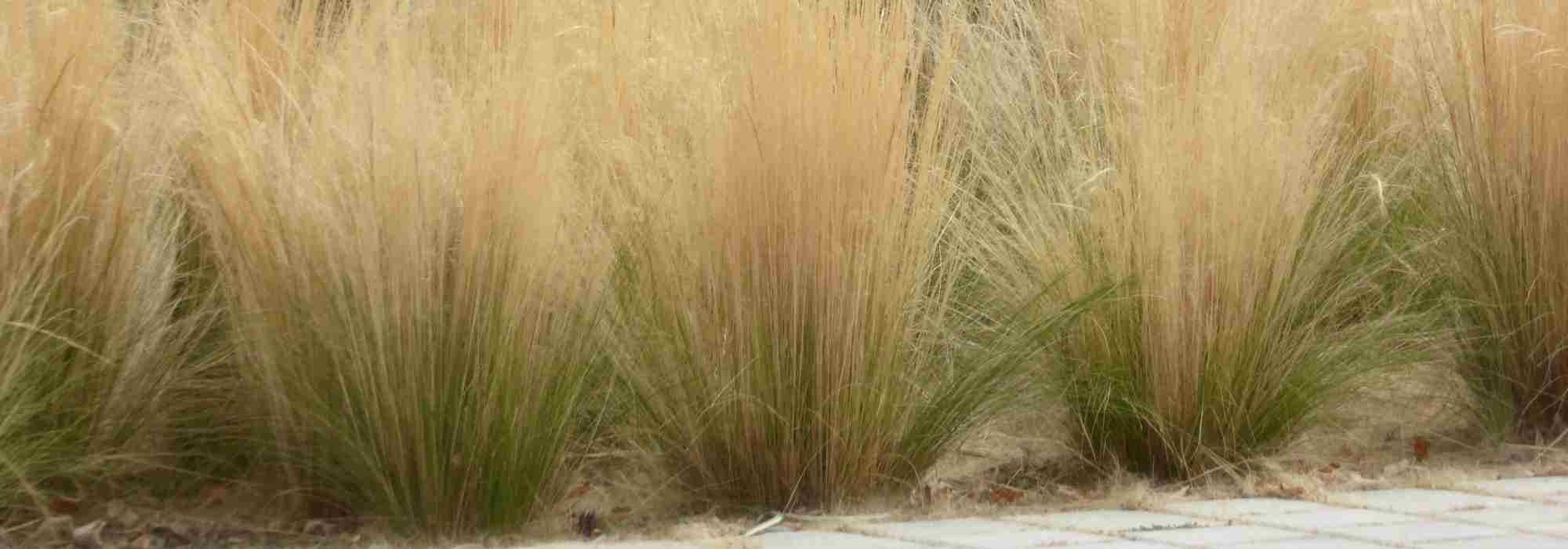
7 ideas for pairing Stipas
Inspiration and tips to showcase your stipas
Contents
Equally at ease in contemporary or natural settings, Stipas bring an irresistible holiday feel to our gardens. Their unparalleled lightness creates airy golden waves always in motion. They really are everywhere… one might even say angel hair Stipas are a little too common in urban layouts, but they are very easy to grow and maintain provided they are planted in well-drained soil and full sun. Stipas tenuifolia, but also Stipas pennata, Stipas gigantea, Stipas calamagrostis… If these pure marvels need space to fully express themselves and are beautiful as solitary specimens, they also enjoy company. Combining them is easy and you can place them in many spots depending on their size and upright or rounded habit: grouped in beds or along paths, in modern gardens or in pots, by the seaside or in rockeries… Discover how to create beautiful combinations with your Stipas!
If you would like more advice to grow Stipa tenuifolia, feel free to consult our fact sheet « Stipas angel hair: Planting, pruning, maintenance »
In a gravel or dry garden
Genus Stipas thrives in dry, poor, calcareous soil. Stipas tenuifolias, also called angel’s hair, are therefore often used in mineral gardens. Stipa capillata, with its narrow leaves, has an upright habit and brings a slightly more modern touch, softened by its long pale spikes in summer. By pairing either with some blue fescues ‘Elijah Blue’ and contrasting mound or cushion forms, one achieves a beautiful effect in a contemporary border: Pittosporum tenuifolium ‘Silver Ball’, Hebe pinguifolia or Hebe rakaiensis, Santolina chamaecyparissus, Euphorbia pythiusa, etc. A restrained trio of Stipas, creeping rosemaries ‘Pointe du Raz’, and blue fescues planted in large drifts is also visually attractive and highly effective. Even more minimalist, a duo of Stipas tenuifolias and Salvia nemorosa or of Agapanthes offers a pleasing contrast in terms of colour and form.

Hebe rakaiensis, Pittosporum tenuifolium ‘Silver Ball’, Stipa capillata (© Gwenaëlle David), Euphorbia pythiusa and Santolina chamaecyparissus
In a less structured mineral garden, introduce some valerians that thrive in dry soil and will provide a long flowering period often missing from mineral gardens, as well as Agapanthes or lavenders ‘Stoechas’, and for a lower stratum some Armeria maritima and Sedums creeping. Two or three Stipas gigantea planted can quite readily occupy a large mineral area, bringing volume and suppleness.
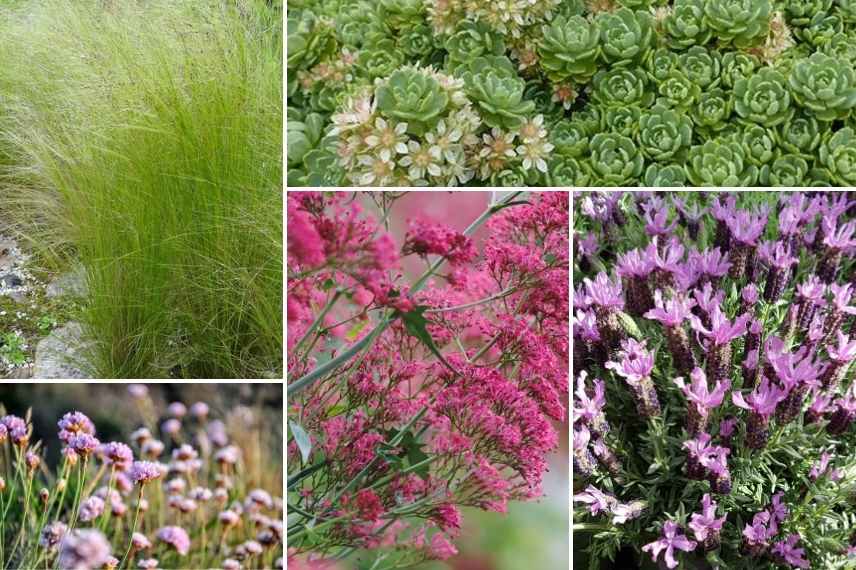
Stipa tenuifolia, Verbena bonariensis, Sedum pachyclados, Centranthus ruber, Lavandula ‘Stoechas’
Mass planting
With their supple, silky habit and foliage that ripples at the slightest breeze, Stipas take over borders, lending them much poetry and lightness. They work wonders when paired with other low grasses such as Melicas ciliata, which respond naturally.
Choose from many varieties such as Stipa capillata, which fits very well in contemporary borders with pink or white Gauras, or the ever-versatile Stipa tenuissima. Taller Stipas such as Stipa gigantea are useful to enrich a large border, where they can be mixed with Miscanthus sinensis ‘Adagio’ or Miscanthus nepalensis, or with Pennisetums.
In an English or country garden, pair your Stipas with a myriad of supple, upright perennials that will bring great grace: Agastaches, Phlox, Verbena bonariensis ‘Lollipop’, Gauras, Stachys byzantina… The flowering of Tritomas, Salvia nemorosa, or certain Aloes will showcase the suppleness of Stipas by contrast with their more vertical habit.
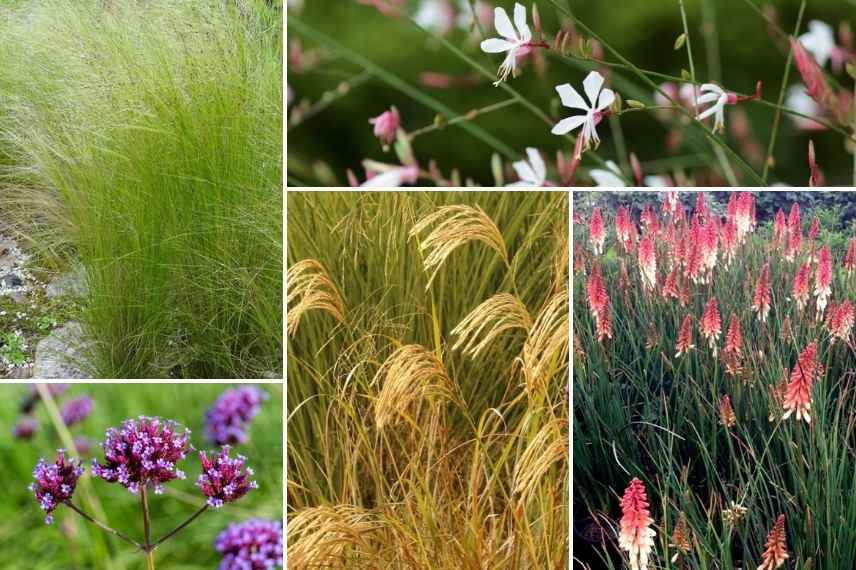
Stipa tenuissima, Verbena bonariensis, Gaura lindheimeri, Miscanthus nepalensis and Tritoma ‘Orange Vanilla Popsicle’
Discover other Stipa
View all →Available in 0 sizes
Available in 2 sizes
Available in 2 sizes
Available in 3 sizes
Available in 3 sizes
Available in 2 sizes
Available in 2 sizes
Available in 2 sizes
Available in 1 sizes
Available in 1 sizes
Rock garden
In a very sunny rockery, the sheen of Stipas is completely enhanced! It is one of the best settings for these silky grasses, which will benefit from particularly well-drained soil due to the elevated position. The well-known Stipa tenuifolia (now encountered under the name Nassella tenuissima) or Stipa barbata are superb in rockeries where their medium size forms very supple arched tufts that can be paired with creeping or low plants. For a Mediterranean « restanque » rockery effect, plant a few Stipa tenuifolia or pulcherrima, and combine with the blue-tinged foliage of the creeping Euphorbia myrsinites, and artemisias, the velvety foliage and yellow flowering of the lovely Ajania pacifica, a few Osteospermums, and dress the low wall with a tapetum of houseleeks and a Yucca filamentosa ‘Ivory Tower’ that will tower above the lot.
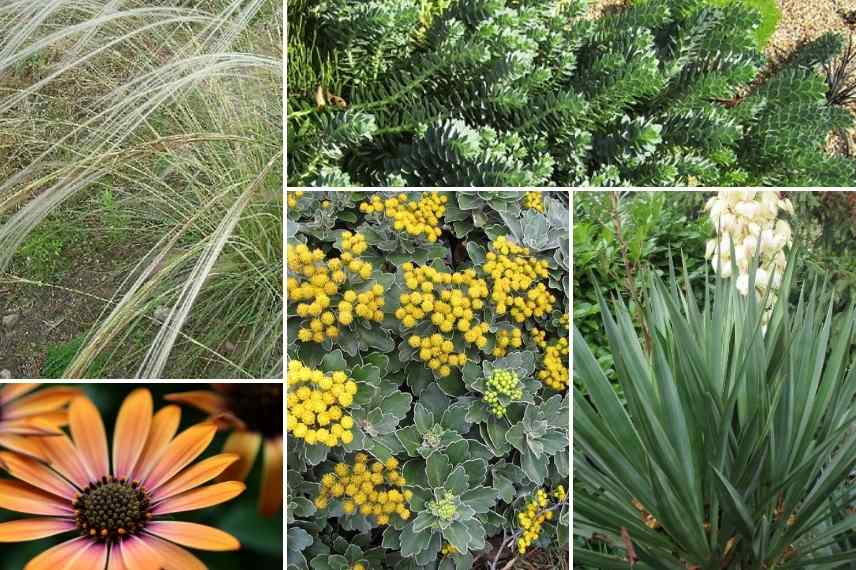
Stipa barbata, Osterospermum, Euphorbia myrsinites (© Leonora Enking), Ajania pacifica (© Forest and Kim Starr), Yucca filamentosa
Along the path
Several Stipas, because of their small size, can make an excellent border along a path: they bring natural charm, highlighting the path’s curves with their silky tufts and lending softness to a straight path or stairway. They hold their shape well all year round, even in winter, which is important for establishing a border. Choose low-growing varieties (50 to 70 cm tall), such as Stipa tenuifolia which remains very airy, or the russet Stipa arundinacea which displays a very ornamental, more rounded tuft, rich in colour. They are beautiful planted along the path, but you can intersperse scabious of similar height, such as the dark Scabiosa ‘Chile Black’ to contrast with Stipa tenuifolia or a white scabious (Scabiosa caucasica ‘Alba’) with Stipa arundinacea.
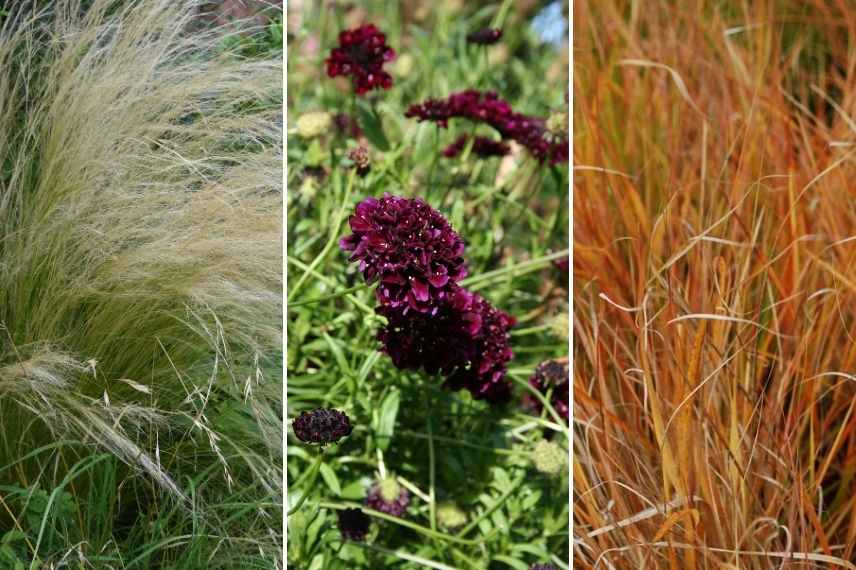
Stipa tenuissima, Scabiosa atropurpurea, Stipa arundinacea
In a natural garden
In a naturalistic or very country-style garden, prefer taller Stipas, which blend particularly well into a lush wild atmosphere. Stipa brachytricha (sometimes still found under name Stipa Achnatherum or ‘diamond grass’) and Stipa calamagrostis are ideal for creating very beautiful scenes. Measuring nearly 1 m at ripeness, they produce for the first large silky grey-pink plumes and for the second white then bronze inflorescences. Habit is more upright in Stipa brachytricha (which also takes on beautiful autumnal tints) and more open for Stipa calamagrostis. You can pair them with undemanding plants of natural inspiration to compose a soothing yellow-and-blue tableau with Eryngiums, Verbena bonariensis, some tall asters such as Aster hybrid ‘Pink Star’ and Achillea. I personally find that Stipa gigantea, which could suit this kind of meadow atmosphere as non-invasive (it does not sucker), is more interesting planted alone or in a mass planting where it is particularly showcased.
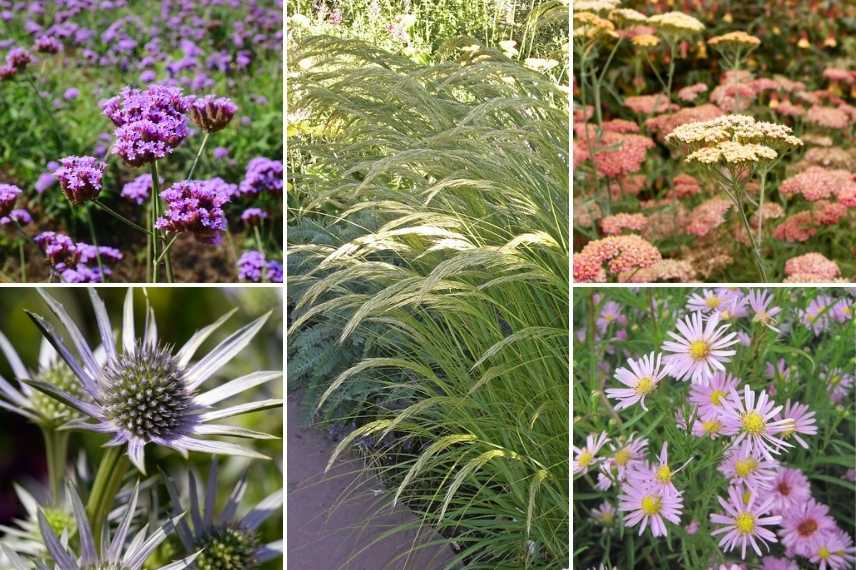
Verbena bonariensis, Eryngium, Stipa calamagrostis (© Andrey Zharkikh) Achillea millefolium, Aster ‘Pink Star’
Potted
Stipas are generally well suited to planting in containers or pots, provided they are given a sufficiently free-draining substrate so they withstand winter damp well, and a very sunny exposure. They are magnificent in the slanting evening light on a west-facing terrace. Choose the lowest-growing or medium-sized Stipas, with clumps that hold their shape, taking care to group several specimens per container to bulk out the very airy appearance of Stipas in this setup. Stipa pennata, Stipa tenuifolia, Stipa barbata can then be paired with very delicate inflorescences such as Erigerons karvinskanius or Gypsophila for a very soft atmosphere in stone troughs that show them off particularly well. For a more contrasting effect, pair them with Carex (‘Comans Bronze’) and Salvias nemorosa ‘Blauhügel’. Another mood, this time 100% grasses, with blue fescues and Uncinia rubra for green, blue and purple variations.
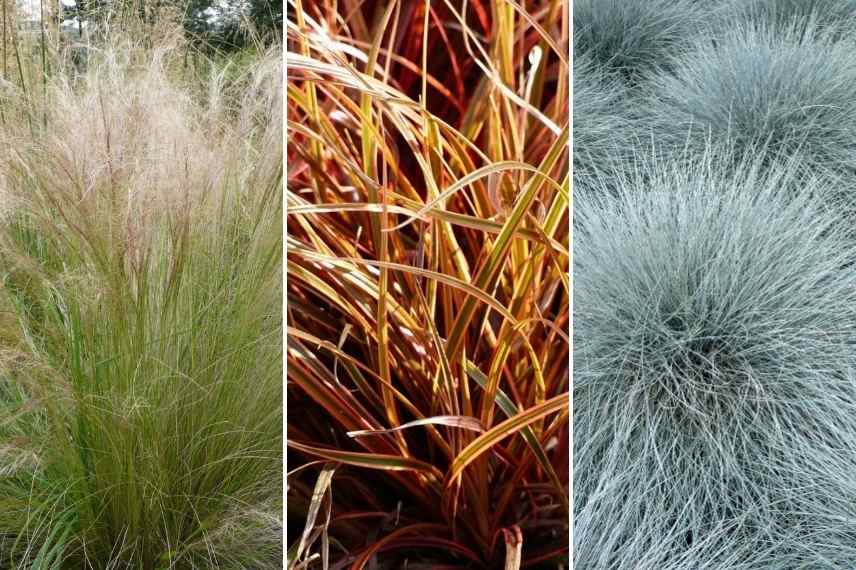
Stipa tenuifolia, Uncinia ‘Belinda’s Find’, Festuca glauca
Seaside
Defying wind and sea spray, Stipas are the ideal candidates for seafront gardens. The golden spikelets that appear in summer on angel’s hair are remarkably delicate and the wind makes them dance like magic. Showcase their incredible undulations with structural perennials and bushes that thrive on the coast such as Echium candicans (viper’s bugloss), Agaves or Phormiums, Euphorbia mellifera, Grevilleas, Proteas, but also the Atriplex halimus, Cistus, Westringias, and a few selected perennials: Gauras, sages, Euphorbia characias, Convolvulus cneorum…

Agave americana ‘Variegata’, Protea, Stipa tenuifolia, Echium candicans, Grevillea rosmarinifolia
- Subscribe!
- Contents
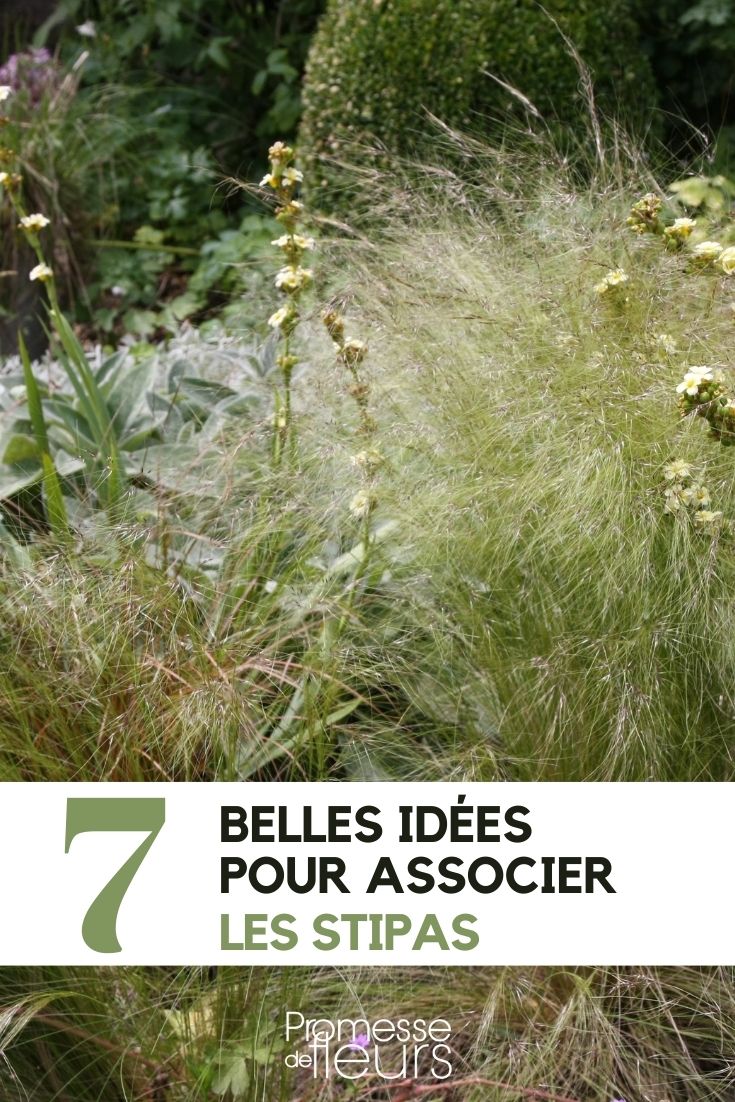































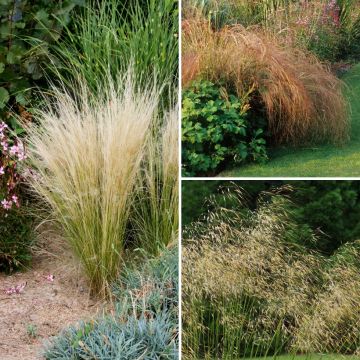
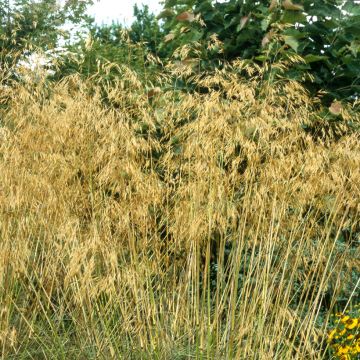
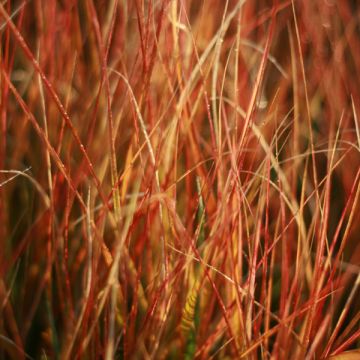
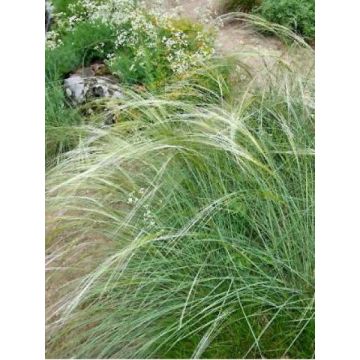

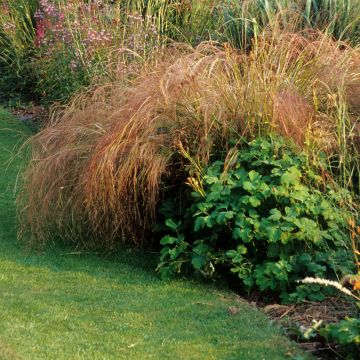
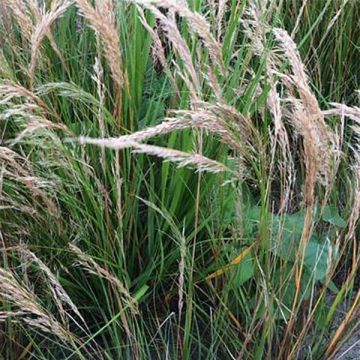
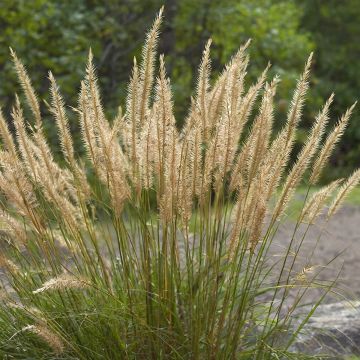
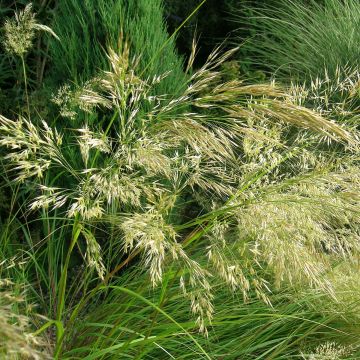
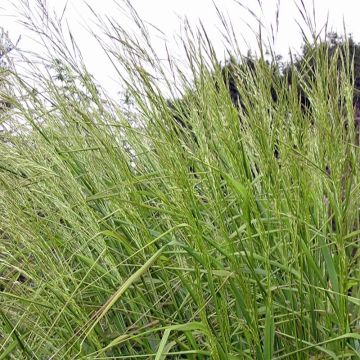
Comments